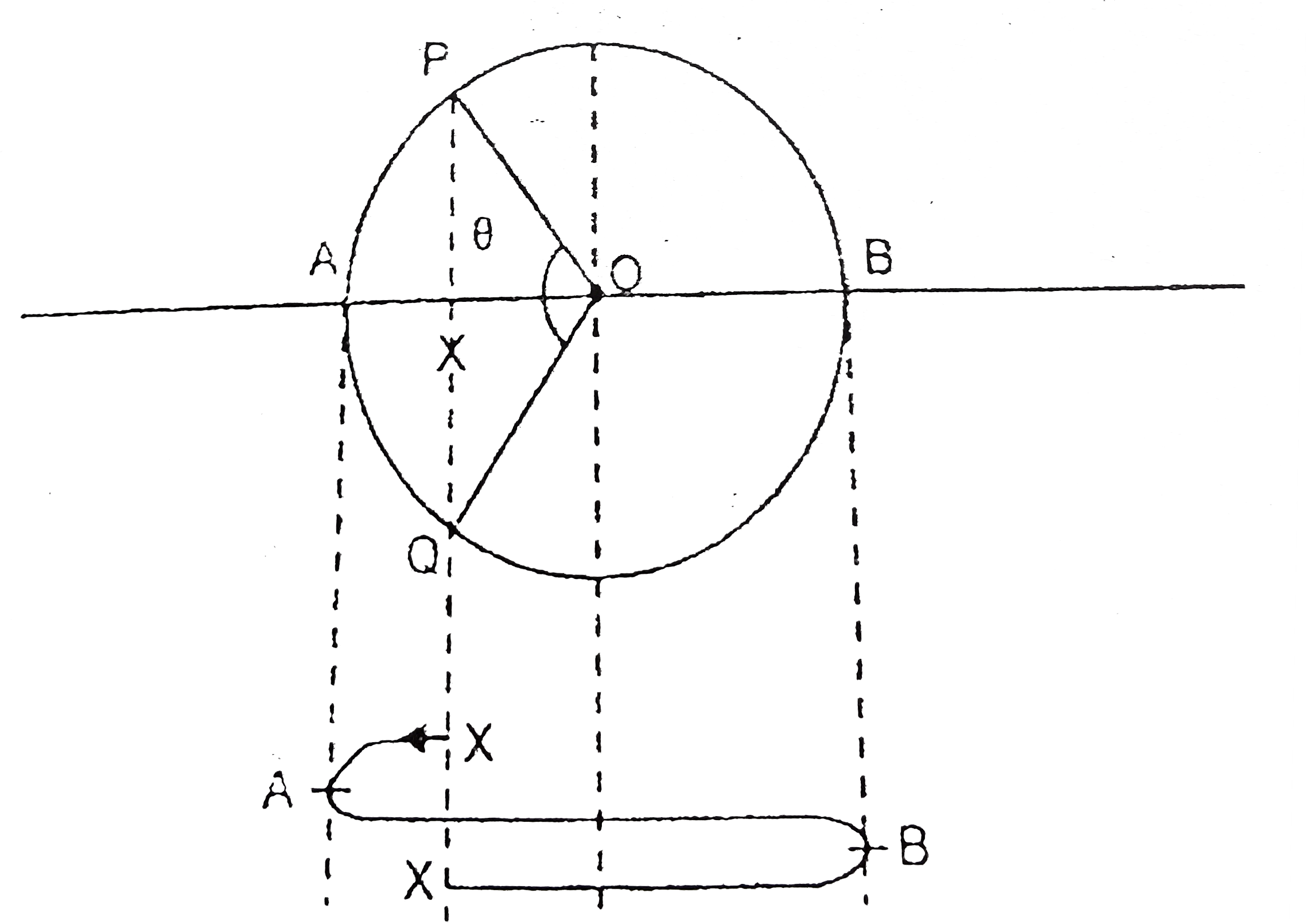A and B are two points on the path of a particle executing SHM in a straight line, at which its velocity is zero. Starting from a certain point X (AX<BX) the particle crosses this pint again at successive intervals of 2 seconds and 4 seconds with a speed of 5m/s
Q. Amplitude of oscillation is
10√3πm
4√2πm
9√2πm
17√2πm
The correct Answer is:C

The given SHM is represented in the figure.
Time period T=2+4=6sec
OX=x0
and OP=A
cos(θ2)=x0A
θ=2π/6×2=2π/3
so cos(θ2)=cos(π3)=12=x0A
or x0=A/2
Now v=ω√A2−x2
or 52=ω2A2−ω2x20=3/4ω2A2
or ωA=10√3
⇒A=10√3ω=10√362π=10√3π
AXBX=A−x0A+x0=A/23A/2=13
Topper's Solved these Questions
- BOOK - RESONANCECHAPTER - TEST PAPERSEXERCISE - PT-0130videos
TEST PAPERS
- BOOK - RESONANCECHAPTER - TEST PAPERSEXERCISE - Pt-0230videos
TEST PAPERS
- BOOK - RESONANCECHAPTER - TEST PAPERSEXERCISE - PART - II PHYSICS107videos
TEST PAPERS
- BOOK - RESONANCECHAPTER - SIMPLE HARMONIC MOTION EXERCISE - Advanced Level Problems13videos
SIMPLE HARMONIC MOTION
- BOOK - RESONANCECHAPTER - TEST SERIESEXERCISE - PHYSICS127videos
TEST SERIES
Similar Questions
A particle is executing SHM in straight line starting its motion at t1=0 with zero initial phase.It crosses a point during the motion at successive intervals at t2=t and t3=2t with a speed v. If its acceleration amplitude is 2πVNt then N is equal to
View SolutionA particle executes SHM in a straight line. In the first second starting from rest it travels distance a and in the next second it travels distance a and in the next second it travels distance d in the same direction. The amplitude of SHM is :
View Solution
Knowledge Check
- Question 1 - Select One
A and B are two points on the path of a particle executing SHM in a straight line, at which its velocity is zero. Starting from a certain point X (AX<BX) the particle crosses this pint again at successive intervals of 2 seconds and 4 seconds with a speed of 5m/s
Q. The ratio AXBX isA2√2−12√2+1B√3−1√3+1C3√2−23√2+2D13 - Question 2 - Select One
X1 and X2 are two points on the path of a particle executing SHM in a straight line, at which its velocity is zero. Starting from a certain point X(X1X<X2X) then particle crosses this point again at successive intervals of 2s and 4s with a speed of 5m/s.
The time period of SHM isA6sB3sC4sD2s - Question 3 - Select One or More
A particle is executing SHM on a straight line. A and B are two points at which its velocity is zero. It passes through a certain point P(AP<BP) at successive intervals of 0.5 sec and 1.5 sec with a speed of 3 m/s. Then
AThe maximum speed of particle is 3√2 m/sBthe maximum speed of particle is √2 m/sCthe ratio APBP is sqr2−1√2+1Dthe ratio APBP is 1√2
(i) The acceleration (a) of a particle moving along a straight line is related to time (t) as per the differential equation d2adt2=−ba. b is a positive constant. Is the particle performing SHM? If yes, what is the time period?
(ii) A particle is executing SHM on a straight line. A and B are two points at which its velocity is zero. It passes through a certain point P (AP>PB) with a speed of 3m/s at times recorded as t = 0, 0.5 s, 2.0 s, 2.5 s, 4.0 s, 4.5 s......Determine the maximum speed of the particle and also the ratio AP/PB.View SolutionA particle moving with a uniform acceleration along a straight line covers distances a and b in successive intervals of p and q second. The acceleration of the particle is
View SolutionA particle is executing SHM on a straight line. A and B are two points at which its velocity is zero. It passes through a certain point P(APltBP) at successive intervals of 0.5s and 1.5 s with a speed of 3m/s.
View SolutionIf a particle executing S.H.M. with amplitude A and maximum velocity vo, then its speed at displacement A/2 is
View SolutionA particle performing SHM starts equilibrium position and its time period is 16 seconds. After 2 seconds its velocity is πm/s. Amplitude of oscillation is
(cos45∘=1√2)View Solution

